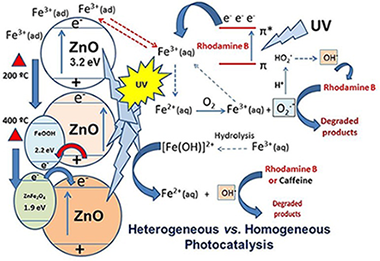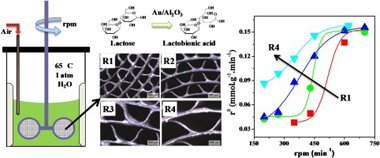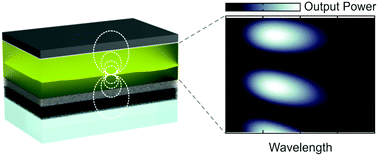Artículos SCI
2020
2020
Nanotecnología en Superficies y Plasma
Robust label-free CuxCoyOz electrochemical sensors for hexose detection during fermentation process monitoring
Lopez-Fernandez, E; Gil-Rostra, J; Espinos, JP; Gonzalez, R; Yubero, F; de Lucas-Consuegra, A; Gonzalez-Elipe, ARSensors and Actuators B-Chemical, 304 (2020) 127360
Show abstract ▽

Label free electrochemical sensors of glucose are used whenever long-term operation and stable response are required. For this purpose, various metals and oxides of the first transition series have been proposed as alternative to more expensive noble metal electrochemical sensors. In this work we propose a new formulation consisting of copper-cobalt mixed oxides which, in the form of porous and nanostructured thin films with well controlled Co/Cu ratio, are prepared at room temperature in one step by a modification of the magnetron sputtering oblique angle deposition procedure. Films with various compositions were electrochemically characterized by cyclic voltammetry to determine their amperometric response to glucose as a function of voltage and NaOH electrolyte concentration. This analysis showed that films with a Co/Cu atomic ratio equal 3.4 presented a maximum sensitivity (0.710 A M−1 cm−2), a small limit of detection (0.105 μM) and a resilient behaviour upon cycling operation and long storage periods that clearly overpassed the performance of copper and cobalt single oxides. The CuxCoyO electrocatalysts also presented a good selectivity towards glucose and fructose in the presence of common interference compounds found in biological fluids (e.g., ascorbic acid, acetaminophen and uric acid), sucrose and ethanol, this latter present in many agrofood liquids. The possibilities of this sensor electrocatalyst have been tested for the analysis of a wine synthetic fermentation process. The comparison of the electrochemical results with conventional analytical methods showed a lineal amperometric response with respect hexose contents in a must at different stages of its transformation into wine.
Febrero, 2020 | DOI: 10.1016/j.snb.2019.127360
Química de Superficies y Catálisis
Recent advances in selective oxidation of biomass-derived platform chemicals over gold catalysts
Megias-Sayago, C; Navarro-Jaen, S; Castillo, R; Ivanova, SCurrent Opinion in Green and Sustainable Chemistry, 21 (2020) 50-55
Show abstract ▽

Gold is without a doubt the best known metal for chemical oxidation. The noblest of the noble metals gained its place because of its resistance to overoxidation, low temperature of operation, especially in gas-phase oxidation, and fairly good selectivity when required. The aim for sustainable development and the need for new technologies open the possibility to introduce new raw materials and new catalyst formulation. That is why new horizons appear in the otherwise uncertain future of gold catalysis. The old glory becomes now a glorious alternative, and this mini-review gives only a small example of it.
Febrero, 2020 | DOI: 10.1016/j.cogsc.2019.12.001
Fotocatálisis Heterogénea: Aplicaciones
Role of Fe(III) in aqueous solution or deposited on ZnO surface in the photoassisted degradation of rhodamine B and caffeine
Tanji, Karim; Navio, J A; Martin-Gomez, A N; Hidalgo, M C; Jaramillo-Paez, C; Naja, Jamal; Hassoune, Hicham; Kherbeche, AbdelhakChemosphere, 241 (2020) 125009
Show abstract ▽

Iron (III) was incorporated, to the surface of a synthesized ZnO, using two nominal molar percentages of Fe (III): 1% and 5% Fe relative to ZnO. Samples dried and calcined at 200 °C and 400 °C for 2 h, were characterized by XRD, XPS, XRF, N2-adsorption-BET and (UV–vis)-DRS. Photocatalytic activities of the catalysts were assessed based on the degradation of rhodamine B (RhB) and caffeine (CAF) in aqueous solution under two irradiation conditions: UV and visible light illumination. Prior to the photocatalytic tests, the interaction of each one of the substrates with either Fe(III) or Fe(II) was studied in homogeneous medium under UV-illumination and oxygenated environment. It was found that Fe (III) can play an important role in homogeneous media in the photoassisted degradation, both of rhodamine B and caffeine, while Fe (II) does not exert a relevant role in the photoassisted degradation of the referred substrates. Fe–ZnO samples display similar or poorer performance than pure ZnO in the presence of UV light for both studied substrates. The phenomenon can be attributed to the formation of either goethite or ZnFe2O4 at the ZnO surface where the coupled Fe3+/Fe2+ can act as recombination centers for the photogenerated charges. On the contrary, all Fe–ZnO samples showed enhanced photocatalytic activity under visible illumination which seems to be independent of the iron content. In this context, the mechanisms for photoassisted degradation of both the substrates in homogeneous medium and photocatalytic degradation are discussed, as well as the role of Fe in the photodegradation processes.
Febrero, 2020 | DOI: 10.1016/j.chemosphere.2019.125009
Química de Superficies y Catálisis
Monolithic stirrer reactor: The selective lactose oxidation in liquid phase over Au/Al2O3 nanostructured catalysts
Regenhardt, SA; Meyer, CI; Sanz, O; Sebastian, V; Ivanova, S; Centeno, MA; Odriozola, JA; Montes, M; Marchi, AJ; Garetto, TFMolecular Catalysis, 481 (2020) 110219
Show abstract ▽

The performance of rotating metallic monolith stirrer reactor was studied for selective lactose oxidation in liquid phase at 65 degrees C, atmospheric pressure and with air as oxidant agent. The Au/Al(2)O(3)deposition on metallic substrates was performed by wash-coating, producing catalyst coating thicknesses between 5 and 20 mu m. Monoliths with different configuration (channel size between 0.36 and 1.06 mm) were used as stirrer blades in a batch reactor. Internal and external mass transfer limitations were observed during liquid phase lactose oxidation. For stirring rates equal or higher than 600 rpm there were no important external diffusional restrictions and this was also independent of the monolith configuration. Coating with thickness higher than 15 mu m presents loss of catalyst effectiveness due to internal diffusional restrictions. Excellent stability in the catalytic tests was obtained after three regeneration-reaction cycles. Regeneration was carried out at 400 degrees C in air flow. Gold particle size distribution in the monolith washcoat, determined by TEM before and after reaction, was homogeneous with a medium size of around 5 nm. This is in agreement with the very good reproducibility and stability obtained in the catalytic tests. After calcination at 500 degrees C, some sintering and a heterogeneous distribution of metal particle size was observed, accompanied by a slight loss in catalyst activity. It is concluded that metallic monolith stirrer reactors are a promising application for selective lactose oxidation in liquid phase.
Febrero, 2020 | DOI: 10.1016/j.mcat.2018.10.014
Materiales Ópticos Multifuncionales
Dipole reorientation and local density of optical states influence the emission of light-emitting electrochemical cells
Jimenez-Solano, Alberto; Martinez-Sarti, Laura; Pertegas, Antonio; Lozano, Gabriel; Bolink, Henk J; Miguez, HernanPhysical Chemistry Chemical Physics, 22 (2020) 92-96
Show abstract ▽

Herein, we analyze the temporal evolution of the electroluminescence of light-emitting electrochemical cells (LECs), a thin-film light-emitting device, in order to maximize the luminous power radiated by these devices. A careful analysis of the spectral and angular distribution of the emission of LECs fabricated under the same experimental conditions allows describing the dynamics of the spatial region from which LECs emit, i.e. the generation zone, as bias is applied. This effect is mediated by dipole reorientation within such an emissive region and its optical environment, since its spatial drift yields a different interplay between the intrinsic emission of the emitters and the local density of optical states of the system. Our results demonstrate that engineering the optical environment in thin-film light-emitting devices is key to maximize their brightness.
Enero, 2020 | DOI: 10.1039/c9cp05505c
- ‹ anterior
- 116 of 420
- siguiente ›














